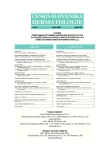-
Medical journals
- Career
Possibilities of High Frequency Ultrasound Use in Dermatology
Authors: K. Fajkošová
Authors‘ workplace: Kožní ambulance Presbyo s. r. o.
Published in: Čes-slov Derm, 80, 2005, No. 1, p. 28-36
Category: New drugs, cosmetics, devices
Overview
In last years the incidence of skin tumors is increasing. Skin tumor diagnostics is based mainly on clinical examination and its accuracy depends on an experience of dermatologist. Patient’s history, macroscopic findings, sometimes with use of magnifying glass, are considered and thus two - dimensional picture of lesion is obtained. However, the information about tumour thickness, which is a basic clue to optimal therapy planning, especially considering laser or cryosurgery treatment, is missing.
Ultrasound devices have been used for several decades in clinical medicine. Their utilization in dermatology is rather recent. Except for tumour diagnostics, they are used for a therapeutical effect monitoring of inflammatory diseases localized in dermis or to diagnose changes in the subcutaneous tissue. The method is widely used in experimental medicine. The mostly used probes working with the frequency of 20 MHz enable to imagine structures 7 mm deep. The main echogenous structure of the dermis is a network of collagen fibres – its alteration causes a change in the ultrasound image. In particular cases the method could contribute to the differential diagnostics but the main scope is still in the detection of structural changes.
This article aims to introduce the possibilities and limitations of this new non-invasive examination method to our dermatologists. By virtue of decreasing acquisition costs it might become readily available.Key words:
ultrasound – A-mode – B-mode
Labels
Dermatology & STDs Paediatric dermatology & STDs
Article was published inCzech-Slovak Dermatology

2005 Issue 1
Most read in this issue- Multicentric Reticulohistiocytosis
- Mycophenolate Mofetil in the Treatment of Some Skin Diseases
- Cutaneous Alternariosis – a Diagnostic and Therapeutic Problem
- Photo(chemo)therapy in Dermatological Treatment
Login#ADS_BOTTOM_SCRIPTS#Forgotten passwordEnter the email address that you registered with. We will send you instructions on how to set a new password.
- Career

